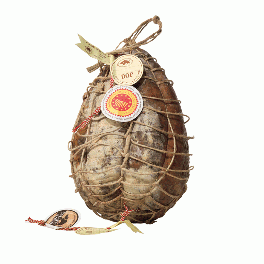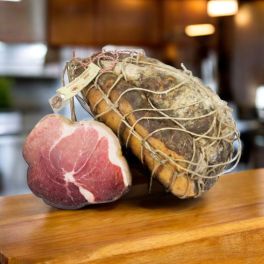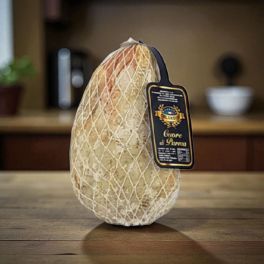Culatello di Zibello: cos'è, dove acquistarlo e perché è il re dei salumi
Culatello di Zibello is a sausage, vaguely similar to ham, but very different in its processing. It is considered a heritage of Emilia Romagna, in particular of the Province of Parma, although it is
famousthroughout Italy and abroad. The climatic regime of the region is considered 'irreplaceable for the maturation and seasoning of culatello'. The cured meat has the Protected Designation of Origin - PDO - mark and there is a consortium to protect the quality of Culatello.
What is culatello?
It is made from the anatomical part of the bundle of posterior and internal crural muscles of the pig's thigh; these are hollowed out on the surface and trimmed to obtain the classic 'pear' shape.
Culatello di Zibello PDO, unlike raw ham, is to all intents and purposes a sausage: the rear muscle is stuffed into the pig's bladder with several turns of food-grade twine. The standard weight of culatello is 3 to 5 kg and it has a characteristic pear shape with a layer of fat in the most convex part.
When cut, the sausage should have a uniform red colour and the fat should be visible between the different white muscle bundles. Its aroma is intense and characteristic, while its flavour is sweet and delicate.
The origins of Culatello date back to ancient times; there are legends that mention its presence as early as 1332, in princely circles. For this reason, Culatello has maintained an aura of being a prized cured meat for many years and, perhaps, this is why it is still called the king of cured meats.
The first demonstrable mention of culatello on paper dates back to 1735, in a document of the Municipality of Parma.
It was then mentioned in the 19th century by the dialectal poet Giuseppe Callegari and the sculptor Renato Brozzi. Documents show that culatello was considered a prized foodstuff limited to the local and upper-class area, at least until the early 20th century.
Not all families, in fact, could afford culatello. It was only towards the middle of the last century that culatello began to be known throughout Italy and subsequently became one of the Made in Italy products exported abroad.
How is Culatello made?
he pigs from which the raw material is obtained must comply with the same criteria required for Crudo di Parma; the culatello specifications allow for salting ingredients other than salt such as:
whole pepper
pieces of garlic
dry white wine,
sodium nitrate
potassium at a maximum dose of 195 p.p.m.
After salting, which takes up to 6 days, the muscle mass is placed in cold storage at a temperature of between 0 and 5 C°, for the time necessary for the salt to be absorbed.
The meat is left to rest and then stuffed into the pig's bladder, using several turns of string that intersect each other, spiralling from the base to the apex. This prevents air pockets fromremaining during curing.
At this point, the culatello is drained and dried for 30 to 60 days; finally, it is matured in special rooms with sufficient air exchange, for a period of no less than 10 months.
Difference between culatta and culatello
A product that is often associated with culatello PDO is culatta or culaccia, a cured meat that is made from the same meat from which culatello is made.
The substantial difference is in the processing: the culatta in fact retains the rind, of which the culatello is deprived, before salting.
In addition, the breech is not PDO-branded, so the ingredients may vary depending on production. For example, some delicatessens may add the sugnatura typical of ham. The rind during curing makes the sausage softer and very sweet.
.
Culatello di Zibello, average price
The average price of Culatello di Zibello varies depending on the weight and months of maturation, but the charcuterie company also influences the price. For example, a 4 kg long-matured Culatello DOP can cost between 290 and 298 euros, if you go for brands such as Negroni; while a culatello of similar weight and long maturation branded Granducato can be around 115 euros.
In our store you can find culatello of all types: 24 and 36 months, either produced by big companies like Negroni or Granducato, or directly from the Culatello consortium.
See our best prices now, some products are already sold out!
Find your bresaola in our online store
If you want to find excellent culatello, you can search our store; you will find products of different weights and prices, ready to be consumed in a short time.
We guarantee the freshness of the product, 100%, so you don't have to worry about the problem of shipping: the bresaola is shipped to you in isothermal containers with an adequate amount of gel ice or you can choose shipment by refrigerated truck.
Discover our products!


 Italiano (IT)
Italiano (IT)  Deutsch (DE)
Deutsch (DE)  Français (FR)
Français (FR)  Español (ES)
Español (ES)  Polish (PL)
Polish (PL) 





Share on: